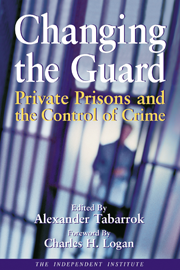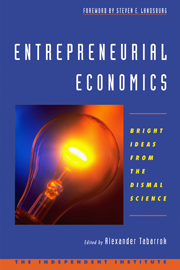Everyone is concerned about the rising price of pharmaceuticals but no one seems to know what to do about the problem. To be sure, solutions are being offered all the time. Among the most popular proposals are imposing price controls on pharmaceuticals, using the bargaining power of the federal and state governments to extract "voluntary" price concessions from pharmaceutical companies, or making it easier for generic drugs to reach the marketplace sooner as the McCain-Schumer bill currently being debated in Congress proposes.
None of these so-called solutions, however, comes to grips with the fundamental tradeoff between lower drug prices and more new drugs. Developing a new drug is an increasingly expensive and risky process. The average cost of bringing a drug to market is now approximately $800 million, and for every 5,000 compounds that are tested in the laboratory it’s estimated that only one will end up as a marketed drug. Pharmaceutical firms spend hundreds of millions of dollars on research only because, if they get lucky, they will invent a blockbuster drug that will earn them billions of dollars in profits. Take away the prospect of a big payoff at the end of the 12 to 15 years of research that it takes to bring a new drug to market, and the incentive to develop new drugs is substantially diminished.
Almost every proposal to control drug prices pretends that this fundamental tradeoff doesn’t exist - but it does. The tradeoff, however, is not insurmountable. Two proposed reforms would in fact lower drug prices without reducing the incentive to create new drugs: patent buyouts and FDA reform.
Harvard economist Michael Kremer explains patent buyouts in his chapter in the new book Entrepreneurial Economics: Bright Ideas from the Dismal Science (Oxford University Press). Kremer argues that the government, or a wealthy non-profit foundation, should buy pharmaceutical patents and turn over the rights to the public for free. Patent buyouts would reduce pharmaceutical prices by 60 to 70 percent because instead of having to wait a decade or more for the patent to expire, generic-drug manufacturers could immediately begin to sell the new drugs in a competitive market.
Patent buyouts would not impede innovation because the innovating firm would be well paid for its research. Indeed, the patent buyer could easily increase the incentive to innovate by raising the buyout price.
But suppose a patent buyer does not know how much the rights to a new drug are worth? What is to stop the patent buyout from becoming a wasteful subsidization of low-quality research? Kremer offers an ingenious solution to this problem: invite patent holders to tender their rights in an open auction. Open and competitive bidding for the rights to the new drug would establish a good estimate of its true value. The government could then use information from the bids to buyout the patent - perhaps with a bid somewhat higher than the top auction bid. Obviously, if the non-government bidders never win the auction they have no incentive to bid accurately - the very motivation for conducting the auction - so Kremer suggests that in randomly chosen auctions the patent rights go to the highest non-government bidder, rather than to the government.
Patent buyouts would be expensive, but the savings to consumers of pharmaceuticals would be even larger. And, as the government is an important buyer of pharmaceuticals through Medicaid and Medicare, a portion of the buyout price would return to it through direct cost-savings.
Kremer’s patent buyout idea complements proposals to restructure the FDA.
The $800 million cost of bringing a new drug to market is not a fact of nature but is largely due to the expense of running FDA-required clinical trials. Clinical trials do have value but the FDA does not weigh the benefits of additional clinical trials against the costs of drug delay, drug loss due to high costs making the production of some drugs unprofitable, and higher drug prices.
The FDA can make two kinds of mistakes. It can permit a bad drug, and it can fail to permit a good drug. The FDA’s biased incentives are a result of the fact that when it permits a drug that turns out to be bad, it is pilloried. But when the FDA refrains from permitting a drug that would have done much good, it usually suffers little criticism. In addition, although the FDA’s approval process is a significant factor in the high cost of drug research, the FDA largely escapes the blame for high drug prices.
As a result of these biases, FDA officials are very concerned that people might die from unsafe FDA-permitted drugs but are much less concerned about the fact that people will die from a lack of effective therapies or high drug prices.
One FDA reform that should be immediately implemented is to allow any drug that has gained permission from the FDA’s counterpart in other advanced countries to be sold in the U.S. (For other reform proposals see www.FDAReview.org.)
If a drug is permitted in the European Union, for example, then within 90 days the FDA should automatically permit it in the U.S. Historically, such countries have permitted drugs faster than the U.S. - with few adverse and many good consequences. Avoiding unnecessary delays and wasteful duplication of approval processes will reduce the costs of bringing new drugs to market, encourage more pharmaceutical research, and reduce drug prices.
Scientific advances are making pharmaceuticals an increasingly important aspect of medical care. Calls for lower prices are thus likely to become more strident as time passes. But the regulatory attempts to reduce prices invariably reduce the introduction of newer, better drugs. If we want to reduce drug prices while maintaining or increasing the incentives to innovate we need to think more entrepreneurially.
Two Bright Ideas to Reduce Drug Prices
Alexander T. Tabarrok is Senior Fellow at the Independent Institute, Assistant Editor of The Independent Review, and Associate Professor of Economics at George Mason University.
EconomyFDA and Drug RegulationFree Market EconomicsGovernment and PoliticsGovernment Waste/PorkHealth and HealthcarePublic Choice
Comments
Before posting, please read our Comment Policy.












